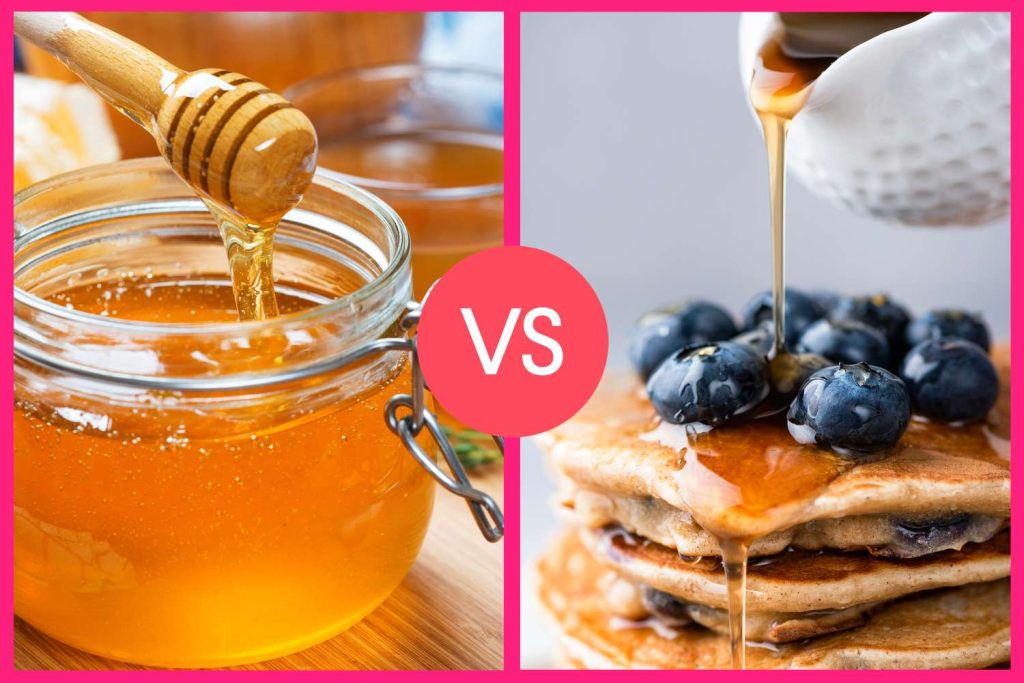:max_bytes(150000):strip_icc():format(jpeg)/honey-vs-maple-syrup-GettyImages-656350932-a936f5039508428481650aaf9838ea12.jpg)
Key Points
- Honey and maple syrup both offer nutrients beyond regular sugar, including antioxidants, vitamins, and minerals, but they are still considered added sugars that should be used sparingly.
- Honey may be better for immune support thanks to its antioxidants, vitamin C, and antimicrobial properties, while maple syrup has a lower glycemic index and is fully plant-based, making it more suitable for vegans.
- Flavor and texture differ—honey is thicker and floral, great for drizzling or marinades, while maple syrup is smoother and caramel-like, ideal for baking, breakfast dishes, and sauces.
When it comes to alternatives for table sugar, honey and maple syrup are popular options. Compared to table sugar, both honey and maple syrup contain more nutrients, along with more complex flavors to boot. But that doesn’t mean these natural sweeteners are exactly the same. Nutritionally, honey and maple syrup are slightly different, which means they offer different health benefits.
If you’re stuck between the sticky sweeteners, consider this expert breakdown of honey vs. maple syrup. Here, dietitians share tips for choosing the best ingredient for your needs, plus what to consider when using sweeteners in general.
- Connie Elick, MS, RD, registered dietitian and instructor of health-centered culinary arts at the Institute of Culinary Education in Los Angeles
- Samantha Peterson, MS, RD, registered dietitian and founder of Simply Wellness
What Is Honey?
Honey is a sticky liquid produced by honeybees. It’s made when bees drink nectar from flowers, then regurgitate it into the beehive. It may sound gross, but the result is a thick, gold-brown sweetener that’s delicious with tea, oatmeal, and baked goods.
Honey Nutrition
The main nutrient in honey is carbohydrates in the form fructose and glucose, two types of simple sugars, according to registered dietitian Connie Elick, MS, RD. “Carbohydrates are the preferred fuel source for the body and brain,” she adds. “Honey also provides trace antioxidants, small amounts of B vitamins, and other compounds with antimicrobial properties,” adds registered dietitian Samantha Peterson, MS, RD. Plus, honey also contains some vitamin C—an antioxidant and essential nutrient that’s “important for wound healing, iron absorption, and the health of skin, blood vessels, and tendons,” explains Elick.
“These plant compounds are part of why honey has been used for centuries in soothing sore throats [and] calming digestion,” says Peterson. Raw honey may provide even more perks, as it isn’t heat processed, allowing it to retain more natural enzymes and beneficial compounds, Peterson notes.
Check out the nutritional info for 1 tablespoon (21 grams) of honey, according to data from the USDA:
Macronutrients
Calories: 63.8 calories
Protein: 0.063 grams (g)
Total Carbohydrates: 17.3 g
Fiber: 0.042 g
Fat: 0 g
Micronutrients
Calcium: 1.26 milligrams (mg)
Iron: 0.088 mg
Magnesium: 0.42 mg
Phosphorus: 0.84 mg
Potassium: 10.9 mg
Sodium: 0.84 mg
Small amounts of zinc, copper, manganese, and selenium
What Is Maple Syrup?
Pure maple syrup is a dark brown liquid sweetener known for its nutty, somewhat woodsy flavor. It’s made from the sap of maple trees, typically sugar maple. The sap is collected from the tree trunks then boiled, which concentrates the sugars.
Maple Syrup Nutrition
Maple syrup, like honey, mostly consists of carbohydrates, according to Elick. This includes sucrose, with some glucose and fructose as well. In addition, maple syrup provides magnesium, an essential mineral involved in energy production and nerve function.
Other notable nutrients in the sweetener include manganese and riboflavin. “Manganese supports bone health and energy metabolism, while riboflavin helps convert food into fuel,” explains Peterson. “Maple syrup also contains antioxidants, though the exact amount can vary depending on how it’s processed,” Peterson adds.
Here’s the nutritional profile of 1 tablespoon (20 grams) of maple syrup, per data from the USDA:
Macronutrients
Calories: 52 calories
Protein: 0.008 grams (g)
Total Carbohydrates: 13.4 g
Fiber: 0 g
Fat: 0.012 g
Micronutrients
Calcium: 20.4 milligrams (mg)
Iron: 0.022 mg
Magnesium: 4.2 mg
Phosphorus: 0.4 mg
Potassium: 42.4 mg
Sodium: 2.4 mg
Small amounts of zinc, copper, manganese, and selenium
Which Sweetener Is Better for You?
Here’s the deal: “Neither honey nor maple syrup is a ‘health food’ in the sense that you want to use them liberally,” explains Peterson. Elick echoes this notion, stating that both ingredients are considered added sugars, which should be limited in one’s diet.
With that in mind, the “better” option depends on what you’re looking for. “It’s more about which qualities align with your taste, lifestyle, and health goals,” Peterson says.
For example, “if you’re focused on antioxidants and immune support, raw honey might edge out [maple syrup],” Peterson explains. Alternatively, if you’re keeping an eye on your insulin response, consider maple syrup. “It generally has a lower glycemic index than honey, meaning it may cause a slightly gentler rise in blood sugar,” Peterson continues. Maple syrup is also plant-based, which is more appropriate for vegan diets and recipes.
You can also consider your desired taste and texture, especially if the aforementioned factors aren’t priorities. “Honey has a sweet, floral flavor and is thicker in consistency,” says Elick. It’s also stickier than maple syrup, “making it great for drizzling over yogurt, blending into teas, or using in marinades where you want it to cling,” Peterson shares. In contrast, “maple syrup has a smoother, caramel-like flavor and pours easily, making it perfect for baking, breakfast dishes, or sauces,” Peterson adds.
Regardless of your pick, remember that natural sweeteners (including honey and maple syrup) are still forms of added sugar. When consumed in excess, added sugars can increase the risk of unwanted weight gain, type 2 diabetes, and heart disease, according to the Centers for Disease Control and Prevention. Therefore, your best bet is to consume both sweeteners in moderation. For context, the experts at the American Heart Association recommend limiting your daily intake of added sugars to 6 teaspoons (2 tablespoons) for women, and 9 teaspoons (3 tablespoons) for men.

